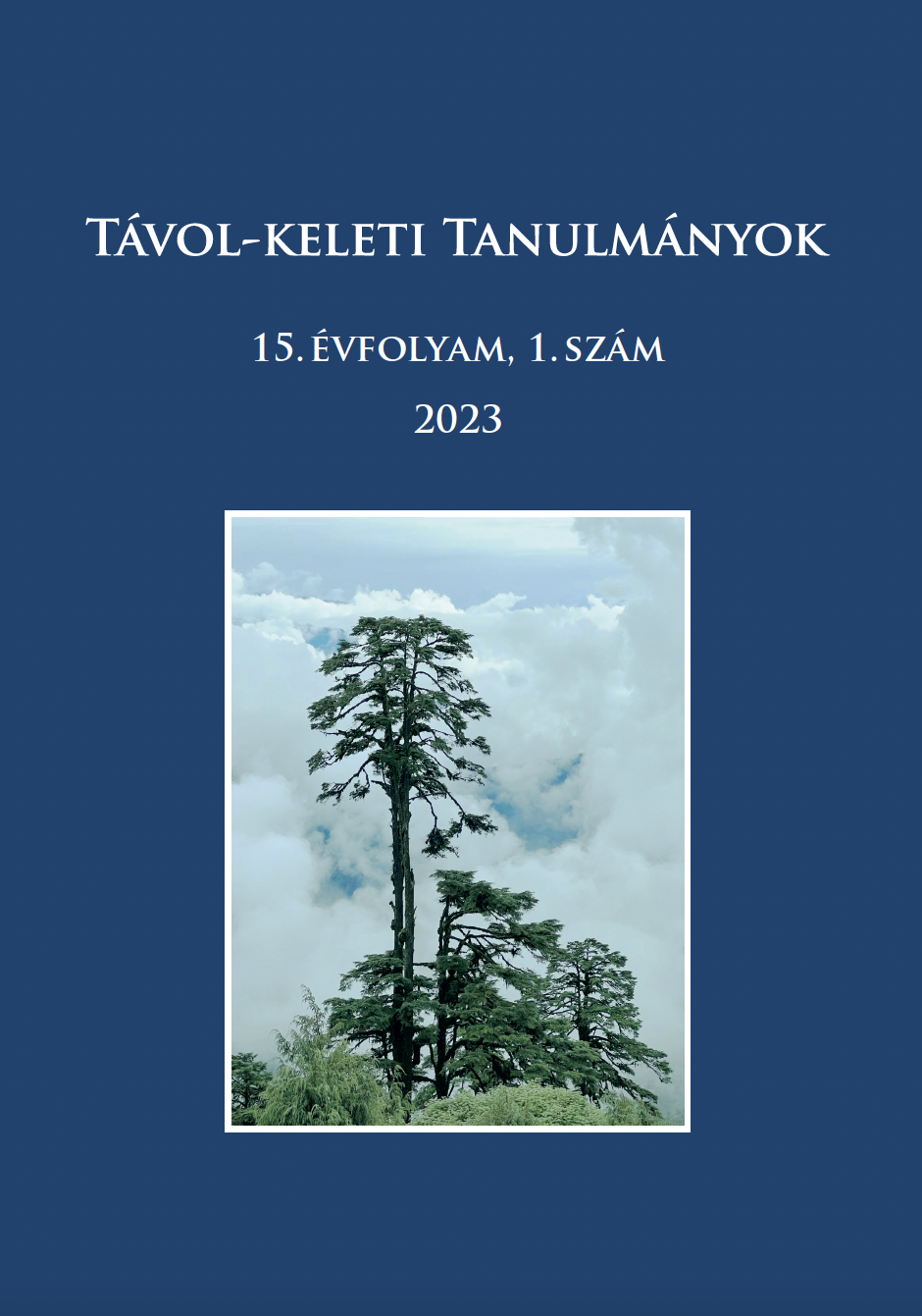The practice of tummo [gtum mo] through Tilopa’s realisation songs and the insight this provides into Tantric Buddhism
Published 2023-05-16
Keywords
- tummo,
- gtum mo,
- Tilopa,
- Naropa,
- Rechungpa
- Tantric Buddhism,
- realisation,
- Six Yogas,
- experience-songs ...More
How to Cite
Copyright (c) 2023 Péter Sándor Galambos

This work is licensed under a Creative Commons Attribution-NonCommercial 4.0 International License.
Abstract
In this essay, I give a brief introduction to the tantric vision of spirituality as lived even today by the yogis in the remote mountains of Tibet. There are many traditions that have survived to the present day, and among them one of the most detailed and whole both in practice and theory is Rechung Nyengyud, the ear-whispered lineage originating from Rechungpa, who in turn inherited all the secret teachings from the Indian Mahasiddhas Tilopa and Naropa. Through concentrating on the existing biographies of Tilopa, which exhibit the typical tantric symbolical description, one can gain an understanding of the world of tantric practice, where the ordinary life, through tantric symbolism and stories, transmutes into pure spirituality, enhancing the everyday situations of the practicing yogis. The most essential requirement is a kind of tantric presence and self-confidence, illustrated through the lives of the Indian Mahasiddhas, of which Tilopa is a perfect embodiment. Moreover, this self-confidence is gained by the yogis at the time of tantric empowerment, where their mortal body and impure mind are introduced by a competent master as a primordially perfect dance of mandalas and a glance at the pure mind of the Buddhas. The essence of tantric practices is the attainment of Mahamudra, the perfect confidence in the purity of unstained mind-essence. For this realisation, the most important practice is tummo (the fierce heat), which is at the centre of Naropa’s Six Yogas, the most well-known of the Tibetan yogic practices. Among Tilopa’s mystical experience-songs, several give a concise but essential description of the exact yogic techniques, theory, signs, and aims of tummo, giving us an in-depth insight into the underlying dynamics of the practice. The traditional secrecy surrounding these practices resulted in many misconceptions and obscurities concerning the reality and potential of Tantric Buddhist practices. Accordingly, my hope is to shed some light through this essay on the reality of tantrism as experienced by its initiated adepts. Recently, there have been many ground-breaking researches and translations of important texts, which undoubtedly help to gain a more holistic understanding about of tantric traditions, but the focus is still on Sanskrit texts. This approach is understandable as the teachings were originated or at least translated through the Indian culture. However, it ignores the fact that a vast body of important texts that were lost in India still survive both textually and as living traditions in Tibet, preserved in faraway monasteries and secluded hermitages. There is much work yet to be done, but as a first step I hope I can provide some insight that could become an inspiration for following investigations into this rich and ancient tradition.
References
- Bde mchog snyan brgyud nor bu skor gsum. Padma dkar po (ed.). Vols. 1–2. Palampur: Sungrab Nyamso Gyunphel Parkhang, 1975.
- CHD = Mi la ras pa: Snyan brgyud las Steng sgo rnam grol gyi chos drug in Ras chung snyan brgyud skor, vol. 4 (Mes po’i shul bzhag 259), 219–256.
- CHNG = Tilópa – Nárópa (author) – Mar pa Chos kyi blo gros (trans.): Chos nyid gnyug ma’i mgur, in Ras chung snyan brgyud skor (vol. 4) (Mes po’i zhal lung 259), 7–8.
- NGDNBM = Nárópa – Marpa (trans.): Snyan brgyud rdo rje rnal ’byor ma, in bDe mchog snyan brgyud nor bu skor gsum, vol. Ga, 95–104.
- Ras chung snyan brgyud skor (vol. 1–19) (Dpal brtsegs bod yig dpe rnying zhib ‘jug khang (ed.) Mes po’i shul bzhag 256–274), Beijing: Khrung go’i bod rig pa dpe skrun khang (2011).
- SGKHKH = Snyan brgyud kyi ‘khrul ‘khor, in Ras chung snyan brgyud skor (vol. 7) (Mes po’i shul bzhag 262), 63–71.
- YCH = Tilópa (author) – Mar pa Chos kyi blo gros (trans.) Śrīsaṃvaropadeśa-mukha-karṇaparacintāmaṇi, Dpal sdomba’i man ngag zhal nas snyan du brgyud pa’i Yid bzhin gyi nor bu = Snyan brgyud yig chung in Derge Tanjur, no. 1529, 23. kötet, 86r–89r.
- YZHNP = Snyan brgyud kyi brgyud pa Yid bzhin nor bu’i phreng ba, in Ras chung snyan brgyud skor (vol. 2) (Mes po’i shul bzhag 257), 1–201.
- YZHNBLG = Yid bzhin nor bu’i lo rgyus, in Ras chung snyan brgyud skor (vol. 2) (Mes po’i shul bzhag 257), 202–370.
- ZDG = Tilópa: Zab mo’i don brgyad, in Bde mchog snyan brgyud nor bu skor gsum, vol. 1, 73–93.
- Duff, Tony 2010. The Bodyless Dakini Dharma: The Dakini Hearing Lineage of the Kagyu. Kathmandu: PKTC.
- Eliade, Mircea 2006. Az örök visszatérés mítosza, avagy a mindenség és a történelem.
- Guenther, Herbert V. 1963. The Life and Teaching of Naropa. Oxford: Oxford University Press.
- Jackson, Roger R. 2004. Tantric Treasures, Three Collections of Mystical Verse from Buddhist India. Oxford: Oxford University Press. https://doi.org/10.1093/0195166418.001.0001
- Roberts, Peter Alan 2000. The Biographies of Ras-chung-pa: The Evolution of a Tibetan Hagiography. Oxford: Harris Manchester College.
- Thrangu, Khenchen 2002. The Life of Tilopa and The Ganges Mahamudra. Crestone‒Auckland: Namo Buddha Publications and Zhyisil Chokyi Ghatsal Publications.
- Marpa 1995. Mar pa Ch. B. (author), Torricelli, F. ‒ Naga S. T. (ford.), Cayley, V. (ed.). The Life of the Mahāsiddha Tilopa. Dharamsala: LTWA. Táranátha 1983.
- Jo Nang Tāranātha (author), Templemann, D. (ed., trans.). Tāranātha’s Bka’. babs. bdun. ldan, The Seven Instruction Lineages by Jo. Nang. Tāranātha. Reprint. Dhar-amsala: LTWA, 2007.
- Torricelli, Fabrizio 1998. "The Tibetan Text of the Karṇatantravajrapada.” East and West 48/3–4: 385–423.
- Tucci, Giuseppe 1999. Tibetan Painted scrolls. Bangkok: SDI Publications.
- White, David Gordon 1996. The Alcemical Body. Siddha Traditions in Medieval India. Chicago‒London: The University of Chicago Press. https://doi.org/10.7208/chicago/9780226149349.001.000135
